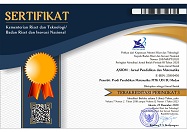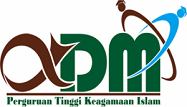Algebraic thinking skills of madrasah tsanawiyah (MTs) students in solving algebraic problems
Abstract
Algebra is a fundamental topic in the mathematics curriculum at Madrasah Tsanawiyah (MTs), yet many students continue to face challenges in solving algebraic problems. This study aims to examine the algebraic thinking skills of eighth-grade students at MTs Unggulan PP Amanatul Ummah Surabaya, particularly through number-oriented and structure-oriented approaches. A descriptive qualitative method was employed, involving 61 students as participants. The instruments included an algebraic thinking test incorporating visual illustrations and in-depth interviews with six selected students representing high, medium, and low ability levels. The findings reveal that only high-ability students were able to effectively apply structure-oriented algebraic thinking. The majority of students demonstrated moderate-level skills, with primary difficulties in constructing mathematical models based on problem structures. These results underscore the importance of instructional strategies that cultivate students’ structural reasoning in algebra. The study provides valuable insights for educators to design learning activities that support the development of students' algebraic thinking, and it serves as a reference for future research to explore targeted interventions aimed at enhancing algebraic problem-solving abilities in MTs students.
Keywords
Full Text:
PDFReferences
Abdima. (2023). Karakteristik madrasah. Abdi Madrasah. https://www.abdimadrasah.com/p/karakteristik-madrasah.html
Alibali, M. (2005). Understanding of symbols at the transition from arithmetic to algebra: the equal sign and letters as variables. Bookings Institution, Falk Auditorium.
Amalliyah, N., Wardono, W., & Mulyono, M. (2022). Analisis kemampuan berpikir aljabar siswa ditinjau dari adversity quotient. Vygotsky, 4(1), 1. https://doi.org/10.30736/voj.v4i1.420
Anggraeni, R., & Herdiman, I. (2018). Kemampuan pemecahan masalah matematik siswa smp pada materi lingkaran berbentuk soal kontekstual ditinjau dari gender. Jurnal Numeracy, 5(1), 19–28. https://doi.org/10.46244/numeracy.v5i1.293
Creswell, J.W. (2012). Qualitative inquiry & research design: choosing among five approaches (3rd ed.). Amerika: SAGE Publications.
Freiman, V., & Lee, L. (2004). Tracking primary students’s understanding of the equality sign. Proceedings of Rhe 28th Conference of the International Group for the Psychology of Mathematics Education, 415–422.
Hardianti, A., & Kurniasari, I. (2019). Kemampuan berpikir aljabar siswa smp dalam menyelesaikan masalah matematika. Jurnal Ilmiah Pendidikan Matematika, 1(5), 59–66. https://doi.org/10.26740/mathedunesa.v9n1.p82-87
Harini, L.P.I., & Oka, T.B. (2016). Penggunaan mind map dalam pembuktian matematika. Jurnal Matematika, 6(1), 56–67. https://doi.org/10.24843/JMAT.2016.v06.i01.p68
Hidayanto, E., Purwanto, Subanji, & Rahardjo, S. (2014). Transisi dari berpikir aritmetis ke berpikir aljabaris. In disertasi dan tesis program pascasarjana um. profil berpikir relasional siswa smp dalam memecahkan masalah aljabar ditinjau dari kemampuan (1).
Indonesia., K.A.R. (2019). Keputusan menteri agama nomor 184 tahun 2019 tentang pedoman implementasi kurikulum pada madrasah.
Indonesia, K.P. (2006). Peraturan menteri pendidikan nasional nomor 22 tahun 2006 tentang standar isi.
Kamarullah. (2017). Pendidikan matematika di sekolah kita. Al Khawarizmi: Jurnal Pendidikan Dan Pembelajaran Matematika, 1(1), 21–32. https://doi.org/10.22373/jppm.v1i1.1729
Kieran, C. (2014). Conceptualizing the learning of algebraic technique: role of tasks and technology.
Krismanto, A. (2004). Aljabar. Malang: Pusat Pengembangan Penataran Guru (PPPG) Matematika.
Kusumaningsih, W., & Herman, T. (2018). Improvement Algebraic Thinkung Ability Using Multiple Representation Strategy on Realistic Mathematics Education. Journal on Mathematics Education, 9(2), 281–290. https://doi.org/10.22342/jme.9.2.5404.281-290
Lenz, D. (2022). The role of variables in relational thinking : an interview study with kindergarten and primary school children. ZDM – Mathematics Education, 54(6), 1181–1197. https://doi.org/10.1007/s11858-022-01419-6
Muallif. (2023). Madrasah tsanawiyah (mts) kurikulum dan perbedaannya dengan smp. Universitas Islam An Nur Lampung. https://an-nur.ac.id/madrasah-tsanawiyah-mts-kurikulum-dan-perbedaannya-dengan-smp/
Napaphun, V. (2012). Relational thinking: arithmetic in order to promote algebraic thinking. Journal of Science and Mathematics Education in Southeast Asia, 35(2), 84–101. https://eric.ed.gov/?id=EJ1001766
Priyanto, & Agus. (2013). Penerapan metode stad dalam peningkatan pembelajaran matematika di sekolah dasar. Kalam Cendika PGSD Kebumen, 2(1). http://jurnal.fkip.uns.ac.id/index.php/pgsdkebumen/article/view/368
Sanit, I.N., & Sulandra, I.M. (2019). Profil penalaran aljabaris siswa dalam memecahkan masalah matematika ditinjau dari adversity quotient. Jurnal Pendidikan: Teori, Penelitian, Dan Pengembangan, 4(9), 1213–1221. https://journal.um.ac.id/index.php/jptpp/article/view/12711/5898
SEO. (2023). Mengenal perbedaan smp dan mts sebelum memilih pendidikan anak. Share Link. https://sekolah.link/informasi-sekolah/sekolah-smp/
Shadiq, F. (2014). Strategi pemodelan pada pemecahan masalah matematika. Yogyakarta: Graha Ilmu.
Siahaan, E.M., Dewi, S., & Said, H.B. (2018). Analisis kemampuan pemecahan masalah matematis berdasarkan teori polya ditinjau dari gaya kognitif field dependent dan field trigonometri kelas x sma n 1 kota jambi. Jurnal Pendidikan Matematika, 2(2), 100–110. https://doi.org/10.33087/phi.v2i2.37
Stacey, K. (2011). The pisa view of mathematical literacy in Indonesia. Journal on Mathematics Education, 2(2), 95–126. https://doi.org/10.22342/jme.2.2.746.95-126
Subanji, S. (2011). Teori berpikir pseudo penalaran kovariasional. Malang: UM Press.
Sudijono, A. (2015). Pengantar statistik pendidikan. Depok: PT. Raja Grafindo Persada.
Sukmawati, A. (2015). Berpikir aljabar dalam menyelesaikan masalah matematika. Math Didactic: Jurnal Pendidikan Matematika, 1(2), 88–93. https://doi.org/0.33654/math.v1i2.5
Widyawati, Astuti, D., & Ijudin, R. (2018). Kemampuan berpikir aljabar siswa dalam menyelesaikan soal cerita ditinjau berdasarkan kemampuan matematika. Jurnal Pendidikan Dan Pembelajaran Khatulistiwa (JPPK), 7(9), 1–8. https://doi.org/10.26418/jppk.v7i9.28886
Yani, M., Ikhsan, M., & Marwan. (2016). Proses berpikir siswa sekolah menengah pertama dalam memecahkan masalah matematika berdasarkan langkah-langkah polya ditinjau dari adversity quotient. Jurnal Pendidikan Matematika, 10(1), 42–57. https://doi.org/10.22342/jpm.10.1.3278.42-57
Zulfah. (2019). Analisis kemampuan peserta didik smp di bangkinang melalui penyelesaian soal pisa 2015. Jurnal Cendekia : Jurnal Pendidikan Matematika, 3(2), 350–362. https://doi.org/10.31004/cendekia.v3i2.126
DOI: http://dx.doi.org/10.30821/axiom.v14i1.18461
Refbacks
- There are currently no refbacks.
Copyright (c) 2025 Mustain Bagus Daroini, Subanji, Santi Irawati

This work is licensed under a Creative Commons Attribution-ShareAlike 4.0 International License.
p-ISSN: 2087-8249 | e-ISSN: 2580-0450
Indexed by:
AXIOM : Jurnal Pendidikan dan Matematika is licensed under a Creative Commons Attribution-ShareAlike 4.0 International License.











